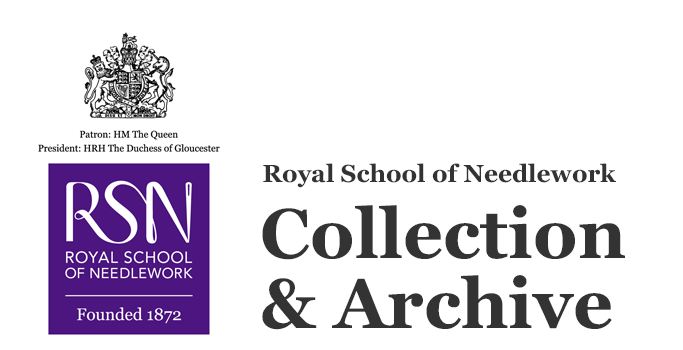Pocket book
Object name
Date made
Circa 1780s
Place made
Description
Circa 1780s tambour work pocket book with a lock and floral designs.
Content description
Circa 1780s pocket book decorated with intricate bird and floral designs on cream silk, worked almost entirely in tambour work. Each panel features a central motif surrounded by a green zigzagging border decorated with gold spangles. Within this border, each panel shows a different floral motif worked using silk thread and passing thread. On the outside of the pocket book, the upper panel shows a small, flying bird with flowers in its beak amongst blue and pink flowers. The pink flowers are likely roses, while the blue ones are probably cornflowers. The lower exterior and interior panels depict roses and two quivers of arrows, accented with more gold spangles. The outer edges of the each panel are outlined in a couched gold thread.
Both of the inside panels have openings at the top to hold goods. The upper inside panel features the original lock plate. The top of the lock is attached to a lightly scalloped flap, which is decorated with a small border of leaves and buds, and to the main pocket panel, which features blue and pink flowers with a small bow, again worked in silk thread and metallic thread. The pocket book's original key is attached to the pocket book with a length of silk ribbon, a replacement for the original blue silk ribbon.
Pocket books were carried by both men and women in the 18th and early 19th centuries, tucked away in a man’s coat pocket or the pockets women wore under their skirts. These pocket books held precious objects such as paper money, letters, important documents, and sewing supplies. In the United States the vast majority of pocket books were adorned in flame stitch designs worked in wool threads, whereas in Europe designs tended to be more floral and worked in silk threads. It is believed that six pocket books from this period were given to the RSN by Mary of Teck, Queen of the United Kingdom and the British Dominions, and Empress of India. This is one of that group.
Both of the inside panels have openings at the top to hold goods. The upper inside panel features the original lock plate. The top of the lock is attached to a lightly scalloped flap, which is decorated with a small border of leaves and buds, and to the main pocket panel, which features blue and pink flowers with a small bow, again worked in silk thread and metallic thread. The pocket book's original key is attached to the pocket book with a length of silk ribbon, a replacement for the original blue silk ribbon.
Pocket books were carried by both men and women in the 18th and early 19th centuries, tucked away in a man’s coat pocket or the pockets women wore under their skirts. These pocket books held precious objects such as paper money, letters, important documents, and sewing supplies. In the United States the vast majority of pocket books were adorned in flame stitch designs worked in wool threads, whereas in Europe designs tended to be more floral and worked in silk threads. It is believed that six pocket books from this period were given to the RSN by Mary of Teck, Queen of the United Kingdom and the British Dominions, and Empress of India. This is one of that group.
Materials
Stitches
Techniques
Motifs
Credit line
Possible gift of Her Majesty Queen Mary.
Catalogue number
RSN.32.f
© Royal School of Needlework

